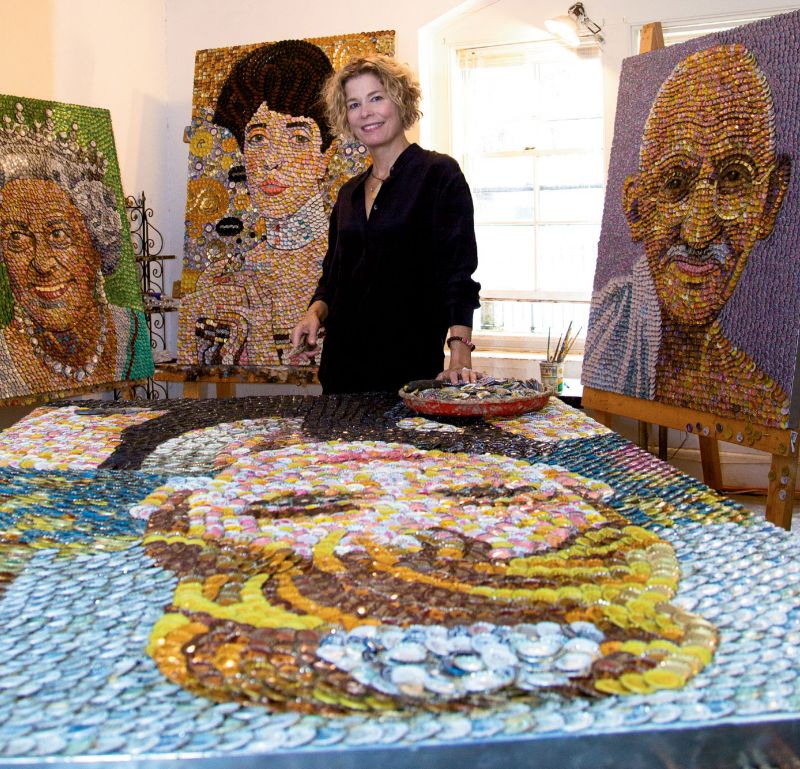
Perhaps it’s the element of surprise that makes Molly B. Right’s portraits so compelling. At first glance, her glittering likenesses of iconic figures (think Queen Elizabeth, Gandhi, Audrey Hepburn) read as glamorous. And they certainly shine gracing the walls of elegant abodes; Right’s large-scale mosaics have landed on the pages of magazines like Coastal Living and Traditional Home. But a closer look reveals that the bright orbs composing each piece are none other than the everyday bottle cap. Right employs some 3,000 vintage caps—which she buys by the boxful on eBay—to produce a single portrait. Her unique works have earned quite a following; they’re snapped up almost as soon as she can make them. (The typical turnaround for a commission is four to six weeks.) Here, Right fills us in on how she got started and why, more than a decade later, she’s still captivated by this unconventional medium.
An early fascination: I collected bottle caps as a kid living downtown. Eventually, I found a whole cache beneath the bottle opener at Marco’s, the old corner store at Queen and Franklin. Soon thereafter, the joy of collecting went away. They were too easily accessible, and it wasn’t a hunt anymore.
Taking the long way: I always wanted to be an artist, but I wasn’t confident in my talent. So I got a degree in horticulture and worked at a garden center. We sold trees in galvanized metal cans; I’d take the containers home and paint designs on them. As I got bolder, my paintings became more representational. One day, I painted a scene with fish, and it seemed like something that could go on a wall instead of on a planter. I cut a seam down the can, opened it like a fan, and hung it up. After that, I started making wall art.
A happy accident: I put my house on the market, and Gary Erwin, the local musician also known as Shrimp City Slim, came to look at the place. He saw my art and asked to buy a few pieces. That was the first time I ever sold my work, and the first time I saw art as a viable career. It emboldened me to keep going.
Finding her medium: There’s a church on Radcliffe Street with “Jesus Saves” printed on the steeple. That inspired a series of narrative paintings riffing on the idea of what Jesus would save if he were to save material items—like the Depression-era stuff my grandparents kept: food stamps, string, rubber bands, pencil nubs. That evolved into the idea of Jesus saving bottle caps. So I did a painting of Jesus and gave him a bottle-cap halo. About a year later, in 2003, I did my first full bottle-cap mosaic, a portrait of Mary.
Trash to treasure: I like taking a lowly object, like the bottle cap, and elevating it into portraiture. There’s an unexpected glamour from the bright colors and the way the caps reflect light.
The “wink” in each piece: I get a kick out of using Purple Passion caps in religious portraits, or placing a Whistle-brand cap near a subject’s mouth.
Saturday routine: Taming the fig vine on the front of my house is a constant endeavor. I’d dissuade anybody from planting one unless they have a staff of gardeners! After that, I might take a walk on Folly Beach or catch a movie at the Terrace Theater with my partner (and fellow artist), David Boatwright.
The thrill of the hunt: I’ve always loved scavenging. Now, I pick chanterelles on John’s and Wadmalaw islands that I use for cooking. It reminds me of hunting for Easter eggs as a child—I get a burst of excitement when I see what I’ve been looking for.